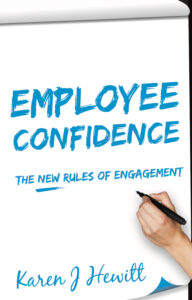Creating Engagement
With so much focus on engagement, you would think that the statistics would dramatically improve. Instead, most of the surveys show employees are not fully engaged. Why is this, and what can be done about it?
In a her book, Employee Confidence: The New Rules of Engagement, Karen J. Hewitt, argues that employee confidence and engagement are intertwined. The difference maker in engagement is confidence. I had a chance to catch up with her and talk about her new book and work.
How to Thrive
What makes an organization thrive?
There is only one thing that makes an organization thrive, and that’s its people. It’s as simple as that. The moment your people stop feeling valued, or supported to achieve their potential, or communicated with, their engagement levels fall. And when this happens, you’re not just looking at engagement problems, but problems with all the other things engagement drives, like quality, productivity and client satisfaction for example.
Even worse, the best employees leave, which inflates costs and blows a big hole in both productivity and the engagement levels of those who remain.
Clever business leaders put 80% of their efforts into their people, because they know that people are the key to everything else they are looking for. It sounds obvious I know, but most leaders do the opposite. They get so hung up on the numbers that they place a disproportionate amount of attention on them, to the detriment of their people.
As soon as they stop taking time to understand what their people need, disengagement is the natural outcome, and with disengagement, the all-important numbers either go downhill or don’t deliver what they could because employees aren’t operating to their potential.
Create an Engaged Culture
How do leaders foster a culture that encourages an engaged, confident workforce?
Fostering a culture like this is easier than we think, but it needs a change in mindset. The workplace can be a challenging environment, with everyone under pressure to do more with less, but this leads us to adopt a task focus rather than a people focus. As human beings we are also hardwired to solve problems and jump straight to solutions.
When these two things combine, they cause us to neglect our people, where the best solutions often lie. It also damages their engagement, and their confidence, because they are not being asked to think, or to contribute their ideas.
So with this mindset shift, that the answers lie with your people, all you need to do then is three things:
First, you create an inspiring vision for your company that gets everyone excited.
Second, you train your people managers to get the best out of their people and make them feel valued at the same time, using coaching techniques to empower them and challenge their thinking.
Third, you invest in all your people, giving them all leadership skills, not just your high potentials.
Why is confidence vitally important for optimal performance?
Confidence is the thing that leads us to take action, and that’s why it’s so important to performance.
Engagement will give us commitment, and to a certain extent, motivation, but it’s only confidence that will lead people to cash in on these two things and take action on them. There is no performance without action, and no action without confidence.
Confidence is the one thing that allows us to operate to the best of our abilities, without overthinking things or sabotaging our own performance.
When we lack it, it doesn’t matter how engaged we are, we just won’t take action to fulfil our potential.
As employers, I feel companies have a duty to help their employees reach their potential, and if confidence is a key part of that, then it needs to become a focus in business.
It’s already a hot topic in high performance sport, because there is less tolerance for error, but for some strange reason, we view the topic as unimportant in business. We tend to assume that everyone is confident, as a default setting, or they wouldn’t be in their jobs, and if people admit a lack of confidence, this might affect their credibility and career chances.
If companies really want optimal performance, they need to recognise that it is human to experience confidence peaks and troughs, and discussing it enables the troughs to be overcome quickly, and the peaks to be capitalized upon.
4 Types of Confidence
Tell us more about the four key types of confidence
I developed a model for confidence with four levels, based on my own experience, observations with colleagues, and interviews with successful people on what confidence means to them.
The four levels are internal, deep, external and strategic confidence, and ideally, they need to be addressed in this order to build a confident workforce as quickly as possible, because each level builds on the previous ones.
 It has taken me thirty years to build all four levels in myself, but with the benefit of hindsight, I can now give others the awareness and the skills they need to fast track it.
It has taken me thirty years to build all four levels in myself, but with the benefit of hindsight, I can now give others the awareness and the skills they need to fast track it.
In business, we tend to think that external confidence – how people show up to others – is all there is. If we look confident, and sound confident, then it’s assumed that we are. It’s essential for influencing others and selling our ideas, but it’s not the whole story.
Internal confidence brings self-acceptance. When you are kinder to yourself, you are kinder to others, and this improves working relationships. You also appear more congruent, essential for leading by example and inspiring others.
Deep confidence is knowing your values and the mark you want to leave in the world, so it keeps employees consistently motivated, especially if there is a strong alignment between what both the employee and the organization want to impact.
Strategic confidence is the final level of confidence, because it really means having the strategies to hang on to those great levels of internal, deep and external confidence, even when overall levels of confidence are being knocked on a daily basis.
What are some of the benefits when a company is filled with people demonstrating strategic confidence?
Having people in a company demonstrating strategic confidence has three clear benefits:
First of all, you have less conflict, because difficult conversations are planned carefully to find common ground. Conflict in organisations is a big blocker of optimal performance, and stops people collaborating to achieve it. Without strategic confidence, employees find it difficult to see the other party’s point of view.
In fact, collaboration is the second benefit to strategic confidence in employees, because it leads people to actively seek out win-win outcomes. I firmly believe that the most innovative solutions and the highest levels of performance come from people working together in organizations and working to a higher common agenda than that of the individuals working on their own or in silos.
Employees versed in strategic confidence know that there is always a win-win outcome, and that it’s the secret to getting the outcome they want without jeopardizing working relationships.
Third, it equips employees to manage their own confidence levels, which is also good for the organization because it means employees manage their own wellbeing.
Encourage Employee Confidence
What are some techniques managers can learn to help encourage employee confidence?
The best way managers can encourage employee confidence is to remember that they create the environment for it. When managers make this their focus, and follow the key principles of transformational leadership, they can quite literally transform their people.
In practical terms, this means adopting a coaching style wherever possible, because coaching is transformational leadership in action.
Of course, there will be times when only a transactional approach will do, for example, when decisions need to be made quickly, but transformational leadership is the best way to empower people and build employee confidence.
Employee confidence happens when people feel engaged, but also confident enough to act on that engagement, and this needs them not just to have the skills, but also to have the belief in their abilities.
Managers can build this belief by asking their people good questions that demonstrate how much they value them, that they’re interested in them as individuals and want to challenge their thinking.
This last point is particularly important because many managers ask only closed questions, which do nothing to stimulate their people’s thinking.
For organizations to be successful, they need to do things differently, and this means managers asking different questions.
How has the response been to your engagement work?
The idea of bringing confidence into discussions around engagement has been met with very strong interest, and I think it’s because so many of us can relate to the ebbs and flows of confidence we experience in the workplace, no matter how motivated we are to achieve.
There is also an interest in my suggestion to let go of engagement for engagement’s sake, and instead focus on where engagement is most needed. With a strong ethical reason to engage, employee confidence starts to build, and engagement becomes a non-issue because it takes care of itself.
My model proposes viewing engagement through a lens of confidence, instead of engagement itself, and this may not suit organizations with a well-established engagement program.
Where they are actively seeking higher levels of performance, however, my engagement model, whether adopted wholesale or via the “70% complete and 30% worked out by the employees” method that I outline in my book can bring definite value.
For more information, see Employee Confidence: The New Rules of Engagement.

